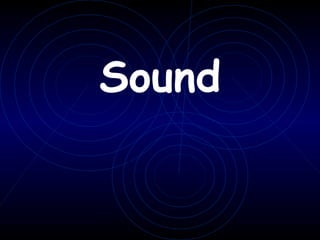
Sound
- 1. Sound
- 5. Sound waves are longitudinal
- 14. Diagram of the Ear
- 18. Beats are formed by the interference if two waves of slightly different frequencies traveling in the same direction. In this case one beat occurs at T-2 where constructive interference is greatest. BEAT (continued)
- 22. the end
Hinweis der Redaktion
- Sound is a longitudinal wave, creating compression and rarefaction areas. Vibrating sources cause air molecules to vibrate, not move. Compression is an area of higher than normal air pressure and rarefaction is an area of lower than normal air pressure. Often easier to represent as a graph of pressure vs distance, which will look like a sine wave. (see p354 bottom). Wavelength, frequency, amplitude, and the mathematic relationships between them all hold. Pitch is often substituted for frequency in music references.
- Speed of sound is highly affected by the temperature and the density of the medium. In general, the speed of sound is greater the more dense the medium is, although there are exceptions (lead < water). Speed of sound in air = (332 + 0.6T) m/s (at normal atmospheric pressure) T is temperature in celsius. Otto von Guericke 1654, did experiments with sound finding that the intensity of sound decreases as air is removed. Also found that sound travels through water. SOUND NEEDS A MATERIAL MEDIUM FOR ITS TRANSMISSION. IT WILL NOT TRAVEL IN A VACUUM.
- Intensity of sound or loudness is difficult to measure because the amount of energy involved is small in comparison to other forms of energy and because the potential range of sound intensity is great. Intensity and intensity level on the decibel scale both decrease as the distance from the source increases. This is due to the energy spreading itself more and more thinly over increased area.
- Measured in decibels, where 0 dB is the threshold of human hearing; 160 dB will destroy the eardrum instantly. Intensity measures Power per unit area; intensity levels (dB) is a nonlinear relationship measuring the difference between two intensities.
- Humans respond to frequencies between 20 and 20,000 Hz (male speaking voice 120 Hz; female, 250 Hz). Infrasonic denotes frequencies of less than 20 Hz; Ultrasonic, greater than 20,000 Hz.
- A concave reflector will focus sound the same as a mirror focuses light at a single point. The reflecctor collects the sound waves and converges them into a small area. Echoes are produced when sound is reflected by a hard surface such as a wall. Can only be heard by the human ear when the time interval b/w the echo and the original sound is greater than 0.1 s and the distance b/w the person and the reflecting surface is greater than 17 m. Other applications: parabolic microphone to pick up distant sounds; echo-sounder to measure depth of sea; sonar devices to locate submarines, monitor fetuses, etc; radar, similar to sonar, but uses radio waves instead of sound.
- Acoustics in buildings. Reverberation occurs when the reflecting surface in less than 17 m away, the echo follows so closely behind the original sound that the original sound appears to be prolonged. Reverberation time is defined as the time required for sound to die away and become inaudible.